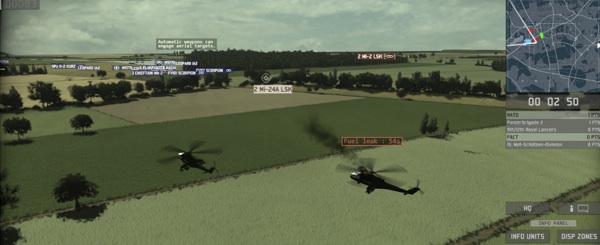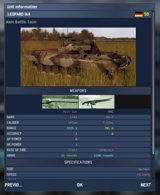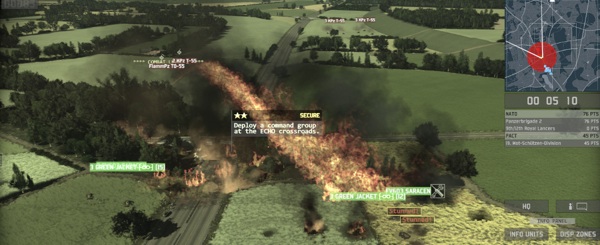Wargame: European Escalation – PC Game Review
 Wargame: European Escalation. PC Game Review. Publisher: Focus Home Interactive. Developer: Eugen Systems. $39.99 download.
Wargame: European Escalation. PC Game Review. Publisher: Focus Home Interactive. Developer: Eugen Systems. $39.99 download.
Passed Inspection: Over 300 well-modeled units to earn throughout the single-player game. Detailed maps feature destructible terrain throughout. Helicopters, flame tanks, rocket artillery—this game has real units you’ve never heard of doing things you’ve never done in an RTS game. A unique gameplay experience.
Failed Basic: Too much of a time sink between learning the game and becoming capable of competing online due to a contrived points system that withholds units from you. An anemic logistics system means always running back to base for a top-off before making the next advance on the enemy. A camera system that groans under the complexity of the engagements you are asked to fight.
{default}Most of my tactical tanking experience comes from World War II games, like the Close Combat or Combat Mission series. In most early scenarios in these games you’ll have perhaps a half-dozen armored units in play at any one time. Each one is incredibly valuable and they are carefully, almost delicately tended to by small teams of infantry who flit around them identifying targets and providing cover to their exposed flank and rear. When tanks come under fire every round they absorb is a wince, every penetration a gasp: Knocked-out tanks can allow a unit’s flank to be quickly rolled up; a crucial probe can cause its fire superiority to dwindle and its momentum to stall.
Rommel famously stated that tanks under his command were to have two speeds, full stop and full speed. This is because tanks in WWII were most accurate when motionless, relying on primitive visual guess-timations or, at best, back-of-the-napkin firing solutions. They were their most vulnerable when in motion, where maneuver exposed their tracks and lightly armored areas to directed fire and limited their ability to locate and engage targets.

Helicopters provide incredible visibility, and select units provide the speed and armor to become a true quick strike threat on the battlefield. Most, however, have to be retreated quickly or they’ll be downed.
Real-life tankers experienced these limitations on the battlefields of northern Africa and Europe in the 40s. Their experiences, and the military-industrial complex of the United States, Europe, and the Soviet Union, advanced mechanized warfare to a sophisticated technical art in the decades that followed. Eventually, range computers became more common, helping tankers quickly compute the distance to a target and mathematically resolve a solution to fire on them. Stabilization of the main gun allowed tanks to fire on the move with increased accuracy. Tanks consequently became more dynamic and more dangerous than ever, diluting Rommel’s famous maxim. A single tank built 30 or 40 years after the end of WWII had the battlefield prowess equal to dozens of its forefathers combined standing still, or perhaps a half dozen while in motion.
New weapons developed to meet this threat. Anti-tank guided missiles (ATGMs) gave light armor and individual soldiers the power to crack open the heaviest tank at a range of hundreds of yards instead of dozens. Helicopters evolved to the point that they could survey the battlefield for miles in any direction, identifying and even engaging armor on their own. To combat them man-portable air defense systems (MANPADS) and mobile anti-aircraft units provided a protective dome over an advancing column and all but drove fixed-wing close air support from the battlefield.
Wargame: European Escalation catches these symmetrical technologies on the upswing and sets them in motion against each other in a fast-paced, real-time game. It tells the what-if story of direct confrontation between NATO and Warsaw Pact forces in central Europe between 1975 and 1985. All these complex and highly specialized units are thrown together, putting the player in control of dozens of armored units, mechanized infantry, and helicopters across maps that span many kilometers.
 All told, Wargame contains more than 300 different infantry, armor, and flying units. The sheer scale of potential combinations boggled my tiny WWII-trained mind. Instead of the choice between fewer Shermans or more Stuarts in my little battle group, I had four different models of main battle tanks to choose from, each with multiple variants, and a huge pool of deployment points for unrestricted spending. My early engagements started by pushing large columns of heavily armored tanks as fast as possible, Rommel-style, through fields and over roads toward the enemy. They ended with wire-guided anti-tank missiles arcing from unseen emplacements, and smoking wreckage scattered behind those same large columns, now in full retreat.
All told, Wargame contains more than 300 different infantry, armor, and flying units. The sheer scale of potential combinations boggled my tiny WWII-trained mind. Instead of the choice between fewer Shermans or more Stuarts in my little battle group, I had four different models of main battle tanks to choose from, each with multiple variants, and a huge pool of deployment points for unrestricted spending. My early engagements started by pushing large columns of heavily armored tanks as fast as possible, Rommel-style, through fields and over roads toward the enemy. They ended with wire-guided anti-tank missiles arcing from unseen emplacements, and smoking wreckage scattered behind those same large columns, now in full retreat.
The early missions do a good job at scaling the difficulty. Surviving them is not easy, and mastering them will take several attempts. Tankers experienced as I am will forsake the usual feint and retreat that characterizes engagements on smaller maps and instead range wide along an enemy’s flank to separate themselves from enemy skirmish units armed with ATGMs. Reconnaissance units can be used to surreptitiously survey positions and plan an advance accordingly, allowing your main battle tanks to sweep in on the enemy flank at the perfect time and location. Helicopters provide more options for recon, as well as some quick strike capabilities. But keeping them airborne can prove difficult, both because of MANPADS and an inability to carry enough fuel to keep them orbiting on station.
That’s because every unit in Wargame tracks its fuel capacity as well as its ammunition, meaning you’ll have to maintain your supply lines throughout the heat of battle.
Here’s where the simulation begins to break down for me. You’re given several units that can carry supplies, including both trucks and helicopters, as well as forward operating bases (FOBs). These units and locations allow for resupply, but they will eventually dry up. Over the course of a game your units will run out of ammunition several times, and perhaps fuel once or twice. The entire system seems contrived to artificially stall and prolong the battles. What I wanted was desperate struggles over key battlefield positions, lightning attacks that cut the enemy in half and destroyed them in detail. What I got was a bunch of units with artificially short functional lifespans queuing up to wait for the next open gas pump and ammo pile. The designers were shooting for realism but ended up with a gamey system that spoils the fun.
For the periods of time you can actually get all your iron moving, the action is quick and decisive. Tanks square up and exchange fire at great ranges while choppers swoop in to pick off stragglers. Wire-guided missiles leap from the tree line and multiple-launch rocket systems (MRLS) lay waste to entire city blocks. Flamethrowers mounted on vehicles spew fire across infantry formations while recon vehicles lurk in the shadows. The visuals are nothing short of spectacular, considering how much is happening on the battlefield at one time.

Russian flamethrower tanks can arc huge gouts of flame over great distances. This generally routs or destroys infantry units, and the scars left on the battlefield are significant. The tanks also have their main gun in place, so tread carefully.
Therein lies the second flaw I found with this game: its camera. Camera controls are simply not up to the task of properly allowing the commander to be in the right place at the right time to help his units. Couple that with the lack of a unit behavior toggle and you have a recipe for disaster. As an example, recon units you carefully slid into position either open fire at the first sign of resistance or mutely wait to be destroyed. If the game demands that I micromanage individual units, then it must allow me to find them and get them into line quickly. The result here is to be frustrated, and require a bit of calming time away from the game before reloading your last save.
I’m sure that Wargame: European Escalation shines in its online format, where up to eight players battle it out on allied teams using a set "deck" of units they bring with them into the battle. Units for multiplay are earned with rewards gained from the single-player game. I became so frustrated with the single-player game that I never earned up enough credits to become a viable threat in the multiplayer realm. When I wandered in players with enhanced decks mopped the floor with me. I’m left asking why the developers chose to deny me, their paying customer, access to the fluid, engaging threat provided by other human players because I lack the patience to plod through the single-player scenarios over and over again.
In the end I wanted to fall in love with this unfamiliar new kind of warfare, but the camera broke my spirits and the logistic model made me cringe before loading it up again.
Armchair General Ranking: 80%
About the Author:
By night Charlie Hall is a writer for Gamers With Jobs (). His relevant interests range from pen-and-paper role playing games, to board games and electronic games of all types. By day he is a writer for CDW Government LLC. Follow him on Twitter @TheWanderer14, or send him hate mail at charlie@gamerswithjobs.com. He, his wife, and daughter make their home in far northern Illinois.


I was a conscript in the dutch army, commanding an AIFV in 1980, and this game really captures the points of fast armored warfare. Supply’s really are very limited, a chaingun can use is AP shell’s in a couple of minuts, so logistics are a problem. A luxury problem that is, because in those day’s the life time of a tank was measured in minutes of actually fighting. A great game of immense depth.
I have to disagree with the reviewer about several things. The camera isn’t bad at all. You can without problem zoom in and out on the battlefield, and locating your uniits ain’t that hard. Recon need to be mircromanaged a bit aye, but you can turn off weapons if you dont want it to reveal itself.
If you don’t like having to resupply often, you can get unit with better fuel efficiency or more ammo. Say you can take leopard 2 instead of Abrams etc.
If you made wise purchase with your command stars, you souldn’t be crushed by so called enhanced decks.
ALSO YOU GET STARS FROM MP ASWELL ! Even if you lose
All you really need to unlock is a recon chopper, 1-2 additional reco units, and armored command units. That’s your basic needs covered.
pick a tank that you lik and unlock it. Nothing wrong with leo1 variants anyway
I got all of my command stars from playing online. There is no need to play single player at all except a mission or two as a tutorial. Also after you get more experienced in MP games you will not have all the supply problems you seem to be having. You will find a natural flow of when you should be buying and sending out supply units and will rarely run out. I have no idea of the camera problems you speak of. For your recon problem you do realize you can “hold fire” right?
I also disagree, Im not a true GROGNARD, (enjoyed Steel Panthers back in the day and Axis and Allies) I found the supply system one of my favorite mechanisms in the game.
It forces you to avoid those simplified ‘Rommel Charges’ that mark standard ‘Craft And CnC style RTS tank rushes. I love giving ground on purpose, slowly picking away at the enemy attack with entrenched AT units… then just as they start slowing down or grouping to resupply, hitting with artillery, and cutting rear lines and command positions with hidden infantry or rotary wing support.
Command stars can be earned by playing the solo campaign or by playing online. Therefore people who plays both solo and online can unlock all the units faster than if they play only solo or online. Howver if you play only the solo you can unlock some units to enbetter your gaming experience. I found that pretty nice for the players who do not really like multiplayer. They can still play with some expensive units
A common mistake is to believe that a deck with unlocked units is better than the basic starting decks. It is possible to win even with basic units, they are cheaper, more numerous, and also the cover given by the terrain can negates a lot of weaknesses. Generally newbies are defeated because they do not know how to make a proper use of their units.
The supply system even if it isn’t perfect or too simplistic from my point of view, is more or less the key of the game. To be honnest, a lot of units are requiring a huge amount of fuel, when you draw the plan for an attack you must know what you need in fuel to cover the distance and manoeuver. You also need to plan your needs in ammo. Especially for missiles. You also need to cover your supply route. I don’t know how many times I simply put an infantry unit near a road, all weapons off to avoid engagement, to capture the supply trucks. Kind of fun to see 4 T80U unable to move because they lack of fuel.
The game itself isn’t a true simulation but a lot of things makes the game fairly more interesting than other RTS. the armor values are different for front/roof/flanks and rear of a vehicule making the heavy tanks a kind of wall beatable only by hitting the flanks or the rear.
The capture and the hold of sectors grants you more points to bring in more troops. The “losses” points system for victory forces the player to take a bit care of its troops. It is not because you have 20 times more units than the opponent that you’ll win. Attrition can be a trap.
The only true flaw in this game is the power of the artillery. Even if it makes it realistic, it breaks a bit the spirit of the game. However corrections are incoming (today apparently) to nerf the artillery against vehicules.
So it is not a perfect game but at least it is one of the most interesting RTS I ever played.
If you like Cold War era wargames, or are just tired of WW 2 all over again, this is the game for you!
I have to say I find this review rather disappointing for a site called “Armchair General”.
The camera system is as easy as it gets: you look straight down and all your and enemy troops have colored, easy to read labels. The screenshots are taken from a perspective that looks really nice and is great for enjoying replays, but mostly useless for commanding your troops.
The supply system is an integral part of gameplay and really easy to use (there is only one type of supply, which repairs, refuels and rearms). Your troops use less fuel when using roads, they use a lot in forests. This makes roads actually important as opposed to other games where they might just be important because the mission description says they are. Also ammo can run out quickly during / after heavy fighting. “Good generals study tactics. Great generals study logistics.” This is a wargame, not Command & Conquer!
Of course this game is not perfect. And it is not a simulation. But if you are looking for a different, slower, more “thinking type” of RTS, watch some gameplay / replays on your favorite video site and maybe join the fight!
A potentially very good game plagued by a horrendous interface, very disorganised and a shoddy camera makes this a 60%
you know nothing. this is the greatest action RTS ever built! and will be made even better with the addition of W:ALB